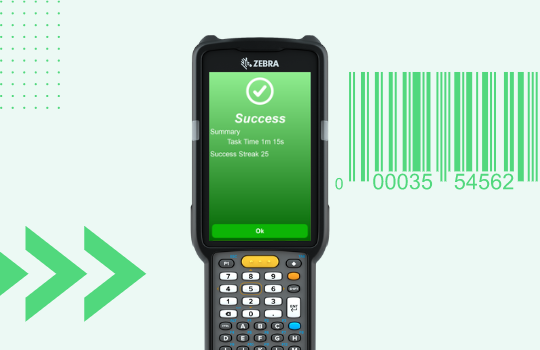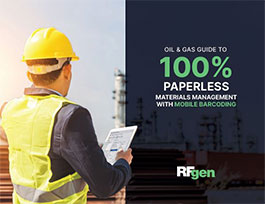The Role of Mobile Data Collection in Oil & Gas
- Compliance
- Data Collection
- Supply Chain
- Oil & Gas
In the oil and gas sector, two things reign supreme: accuracy and compliance. The industry finds itself at the confluence of rising global demands and dwindling easy-to-access reserves. For manufacturers supporting oil and gas, quality and cost control are top-of-mind concerns.
To stay competitive, oil and gas companies must continue to evolve with the times. Mobile data collection offers a flexible, adaptable solution to ensuring accuracy, quality, and compliance with ease.
Instead of sinking huge investments in complex enterprise solutions, a simpler, more cost-effective alternative for data collection could be key to gaining benefits without breaking budgets.
The Role of Data Collection in Oil & Gas
Inventory is the lifeblood of your business. How you track inventory, from raw materials to spare parts, has a direct impact on your efficiency, affecting costs.
If you’re one of the many companies still using paper processes or data entry in your materials management, then you’ve already fallen behind top competitors in your market space.
Consider this: According to one publication, paper tracking methods can add up to $100,000 per year in overhead costs for oil and gas companies. That’s $100,000 that could be reallocated to growth projects or other revenue-generating investments.
Manufacturers, distributors, and drilling companies need modern real-time data collection with perfect accuracy, no matter where they work. These types of businesses must also have accurate data to ensure compliance with regulatory bodies without sacrificing product quality.
Mobile data collection offers a path forward.

How to Ditch Paper for Digital Inventory with Mobile Barcoding
LEARN MORE »Challenges of Compliance in the Oil and Gas Sector
Oil & Gas Compliance is Complicated
Compliance with industry regulations remains a persistent challenge for oil and gas companies. According to PricewaterhouseCoopers, compliance is complex, requiring businesses to navigate several different geopolitical, environmental, energy, and natural resource supply and trading areas.
Stakeholder and business relationships only add to the matrix of complexities. And yet failing to uphold compliance measures is not an option. That’s why oil and gas companies turn to technology to help with compliance through heightened material visibility.
Visibility’s Role in Compliance
Visibility is as integral to inventory management in the oil and gas industry as compliance. Oil and gas products can be volatile, perishable, and hazardous, demanding specialized equipment, meticulous safety protocols, and a keen adherence to regulations.
For instance, transportation requires special equipment, compliance with strict regulations, and extensive safety procedures, according to Inbound Logistics.
“If an oil rig goes down as a result of not having the proper materials in place, it can mean the loss of $1 million every day,” Brian Murphy, Menlo Worldwide Logistics’ director of business development, told Inbound Logistics. “Logistics reliability is paramount—oil and gas companies will invest in outsourcing to ensure there is no service interruption, rather than risk a problem.”
Extraction and storage are no different. Oil and gas equipment manufacturers must produce components and finished goods to very high standards to ensure machine reliability and human safety.
Ensuring the appropriate levels of materials and spare parts are on hand at any given time requires flawless inventory visibility. Not knowing if critical replacements are available when equipment breaks—or where they are located—could lead to losses of hundreds of thousands of dollars per hour.
Left unsolved, equipment problems put workers, wildlife, and the public at risk of harm.

Why Mobile Barcoding is an Essential Best Practice for Oil & Gas
READ NOW »Mobile Data Collection: Transforming the Oil & Gas Supply Chain
Mobile data collection can impact the way oil and gas companies move within the supply chain and comply with industry regulations. Armed with mobile devices, employees are able to collect data from the field, increasing visibility and process cycles and reducing operating costs.
The Benefits of Mobile Barcoding in Oil & Gas
One mobile data collection solution called mobile barcoding has been streamlining oil and gas manufacturing processes for decades. Benefits include:
- 24/7 visibility in facilities in the field
- 99.99% accuracy or higher in real time
- Maximized asset uptime
- Enhanced safety and traceability compliance
- Minimized losses of data, material, and productivity
Mobile barcoding can streamline materials management for:
- Drilling, extraction, and mining operations
- Bulk receiving, storage, and consumption of raw materials
- Refining or recovery of natural gas into finished products
- Discrete and process manufacturing visibility
- Allocating equipment, tools, parts, and consumables
- Managing inventory and equipment in the field
- Transportation, resupply, and delivery of bulk

Get the Guide: Real-time Inventory and Asset Tracking in Oil & Gas
DOWNLOAD NOW »Mobile Barcoding Improves Field Operations
Traditionally, the industry depended heavily on manual (often paper-based) data recording methods—practices fraught with inefficiencies and inaccuracies. Mobile solutions for oil and gas transform these obsolete processes into real-time data collection and transactions with the ERP system, both inside facilities and during field operations.
Imagine a scenario where a field operator detects a potential equipment malfunction. Using mobile data collection tools, they can immediately record the anomaly, complement it with photographic evidence, geo-tag the location, and trigger a maintenance request.
Maintenance technicians are automatically assigned a work order that lists all the required documentation, parts, and locations. Using this information, the team quickly locates the required parts and tools, goes to the site, and makes the repair.
This immediate response mechanism drastically reduces downtime, preempts larger malfunctions, and boosts overall operational efficiency. If any of these steps had been manual, the potential for delays at each point in the process is significant.
More critically, with consistent data input from various operational touchpoints, companies can garner a holistic view of their operations, enabling predictive analytics and proactive decision-making.
WATCH VIDEO: How one global LNG exporter transformed inventory control »
Harnessing Data for Informed Future Decision-Making
Change is the new normal in the oil and gas sector. As the industry seeks to reinvent itself in the wake of climate change in favor of a more sustainable future, companies must increasingly leverage smart data to keep up. PricewaterhouseCoopers’ oil and gas experts continue to underscore the need for effective, strategic decision-making based on that data.
Automating data capture could be the key to extracting reliable, actionable information used in those decisions. Whether it’s accessing data from a remote offshore rig or planning for material consumption during production, real-time data access ensures that decisions are informed and timely. The resulting visibility can assist with regulatory compliance while also driving down costs and enabling the prediction of trends, chokepoints, and areas of optimization.
By harnessing the power of real-time mobile data collection technologies like mobile barcoding, oil and gas companies can optimize operations, fortify compliance mechanisms, and carve out an immediate competitive edge with long-term benefits.





